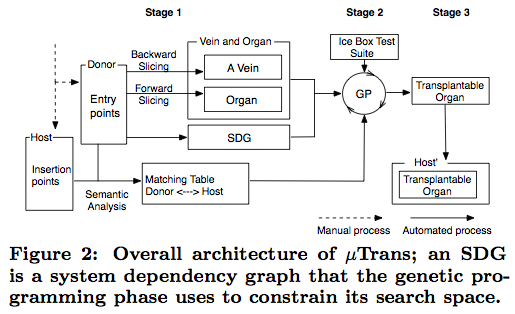Automated Software Transplantation
Overview
Automated transplantation would open many exciting avenues for software development: suppose we could autotransplant code from one system into another, entirely unrelated, system. This paper introduces a theory, algorithm, and tool that achieve this. Leveraging lightweight annotation, program analysis identifies an organ (interesting behavior to transplant); testing validates that the organ exhibits the desired behavior during its extraction and after its implantation into a host. While we do not claim automated transplantation is now a solved problem, our results are encouraging: we report that in 12 of 15 experiments, involving 5 donors and 3 hosts (all popular real-world systems), we successfully autotransplanted new functionality and passed all regression tests. Autotransplantation is also already useful: in 26 hours computation time we successfully autotransplanted the H.264 video encoding functionality from the x264 system to the VLC media player; compare this to upgrading x264 within VLC, a task that we estimate, from VLC’s version history, took human programmers an average of 20 days of elapsed, as opposed to dedicated, time.
Our paper is available for download . The paper was presented at ISSTA 2015, where it won one of the ACM SIGSOFT Distinguished Paper Awards. The slides from the presentation are also available: slides.
The μTrans Approach
The figure below shows the overall architecture of the μTrans approach to the software transplantation problem. Given an organ’s entry point Ol and TDO, a test suite that exercises O’s behaviour, μTrans progressively “evolves” O and V by adding code along a path (a vein) from donor start to Ol. The search space of possible organ veins is enormous, consisting of all combinations of all valid statements and variables of the desired functionality in the donor and host. To explore this search space efficiently, we therefore separate our approach into two stages.
In the first, organ-extraction stage, we employ static analysis to slice out an initial, conversative over-approximation of the organ and one of its veins. In the second, organ implantation stage, we apply genetic programming, using the donor’s test suite, against the reduced search space produced by the first phase to evolve the organ and its vein to fit the “ecosystem” defined by LH , the insertion context in the host. The third stage implants the organ into the beneficiary automatically. Finally, we apply additional testing to validate the correctness of the transplanted host.

2014 © Earl T. Barr, Mark Harman, Yue Jia, Alexandru Marginean, and Justyna Petke